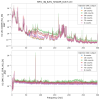I compared the spectra of OMC trans (top left), calibrated OMC length (top right), OMC QPD (bottom left), and calibrated geophone (bottom right) with and without the tapping around the most sensitive area, as described in klog:30469.
The OMC length is calibrated by the factor estimated in klog:30497.
Forcusing on the 90 Hz peak, the OMC length reaches ~1e-11 m/√Hz during the tapping, which is caused by the table displacement of ~1e-9 m/√Hz.
This OMC length causes a relative intensity noise of ~1e-5 /√Hz in OMC trans.
The Q-value of the 90 Hz resonance seems to be around 100, so the transfer function from the optics table to OMC length can be roughly estimated to be ~1e-4.
This value is reasonable, because the vertical seismic isolation factor around 100 Hz is approximately 100, and the common mode rejection of the semi-monolithic OMC can be around 100 due to the low first elastic mode of the OMC breadboard at ~1 kHz.
Without the tapping, the displacement of the optics table is ~1e-10 m/√Hz around 100 Hz, leading to ~1e-13 m/√Hz in OMC length noise at the peak and causing the OMC trans RIN of ~1e-7.
Therefore, we cannot reach the shot noise level of OMC trans ~1e-8 /√Hz.
To reduce the acoustic noise and reach the shot noise level around 100 Hz, we should consider some strategies.
Potential strategies are as follows:
- Improving the vibration isolation of the stack (recovering the stack performance in TAMA era)
- Improving the common mode rejection of the semi-monolithic OMC
- Removing the vibration source around 100 Hz
- Strong control and reduction of OMC length by high-UGF OMC LSC above 100 Hz
- Lowering the OMC finesse

























